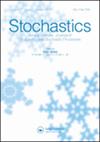风险厌恶的谢普瓮的最优停站
IF 0.9
4区 数学
Q3 MATHEMATICS, APPLIED
Stochastics-An International Journal of Probability and Stochastic Processes
Pub Date : 2015-04-10
DOI:10.1080/17442508.2014.995660
引用次数: 4
摘要
一个(m,p)瓮包含m个值为- 1的球和p个值为+1的球。玩家从k开始,在每一局游戏中抽到一个球,如果球是正的,则财富增加一个单位,如果球是负的,则财富减少一个单位,当k = 0(风险规避)时必须停止。设V(m,p,k)为对策的期望值。我们正在研究最小k的问题,使得游戏V(m,p,k)−k的净增益函数在离散和连续(布朗桥)设置中都是正的。建立了博弈的值函数和净增益函数在m、p、k各参数的单调性。对于截止值k,由于m−p < 0的情况是平凡的,对于p→∞,要么,当增益函数不能为正,要么,当它足以有,其中α是常数。我们还确定了一个近似的最优策略,其失败概率在p方面呈指数级小。问题可以追溯到Shepp[8],他确定了净增益不依赖于k的无限制情况下的常数α。在连续设置中给出了他的结果的新证明。本文章由计算机程序翻译,如有差异,请以英文原文为准。
Optimal stopping for Shepp's urn with risk aversion
An (m,p) urn contains m balls of value − 1 and p balls of value +1. A player starts with fortune k and in each game draws a ball without replacement with the fortune increasing by one unit if the ball is positive and decreasing by one unit if the ball is negative, having to stop when k = 0 (risk aversion). Let V(m,p,k) be the expected value of the game. We are studying the question of the minimum k such that the net gain function of the game V(m,p,k) − k is positive, in both the discrete and the continuous (Brownian bridge) settings. Monotonicity in various parameters m, p, k is established for both the value and the net gain functions of the game. For the cut-off value k, since the case m − p < 0 is trivial, for p → ∞, either , when the gain function cannot be positive, or , when it is sufficient to have , where α is a constant. We also determine an approximate optimal strategy with exponentially small probability of failure in terms of p. The problem goes back to Shepp [8], who determined the constant α in the unrestricted case when the net gain does not depend on k. A new proof of his result is given in the continuous setting.
求助全文
通过发布文献求助,成功后即可免费获取论文全文。
去求助
来源期刊

Stochastics-An International Journal of Probability and Stochastic Processes
MATHEMATICS, APPLIED-STATISTICS & PROBABILITY
CiteScore
1.90
自引率
0.00%
发文量
42
审稿时长
>12 weeks
期刊介绍:
Stochastics: An International Journal of Probability and Stochastic Processes is a world-leading journal publishing research concerned with stochastic processes and their applications in the modelling, analysis and optimization of stochastic systems, i.e. processes characterized both by temporal or spatial evolution and by the presence of random effects.
Articles are published dealing with all aspects of stochastic systems analysis, characterization problems, stochastic modelling and identification, optimization, filtering and control and with related questions in the theory of stochastic processes. The journal also solicits papers dealing with significant applications of stochastic process theory to problems in engineering systems, the physical and life sciences, economics and other areas. Proposals for special issues in cutting-edge areas are welcome and should be directed to the Editor-in-Chief who will review accordingly.
In recent years there has been a growing interaction between current research in probability theory and problems in stochastic systems. The objective of Stochastics is to encourage this trend, promoting an awareness of the latest theoretical developments on the one hand and of mathematical problems arising in applications on the other.
 求助内容:
求助内容: 应助结果提醒方式:
应助结果提醒方式:


